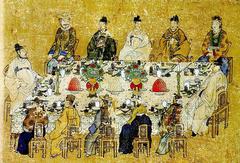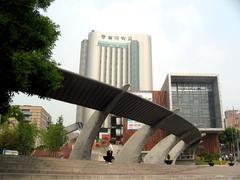
Soongsil University Visiting Guide: Seoul, South Korea — Tickets, Hours, and Attractions
Date: 14/06/2025
Introduction
Soongsil University, founded in 1897, is one of Seoul’s most historic and prestigious institutions, offering visitors a unique window into Korea’s educational heritage, Christian legacy, and cultural development. Located in Dongjak District, the university was established by American Presbyterian missionary Dr. William M. Baird in Pyongyang, making it Korea’s first modern educational institution. Over its long history, Soongsil has played a pivotal role in academic innovation, national resilience, and the promotion of truth and service, especially during turbulent periods such as the Japanese colonial era (Soongsil University Visitor Guide; Wikipedia; Top Universities; Times Higher Education).
Today, Soongsil University welcomes visitors to a vibrant campus that seamlessly blends modern academic facilities with historically significant landmarks, including the renowned Korean Christian Museum—the first of its kind in Korea (Korean Christian Museum). Easily accessible via Seoul Subway Line 7, the campus offers free admission, guided tours, and is fully wheelchair accessible. This comprehensive guide details everything you need to know about planning a visit, including hours, ticketing, campus highlights, nearby attractions, and practical travel tips.
Table of Contents
- Introduction
- History of Soongsil University
- Contributions to Korean Christianity and Cultural Heritage
- Visiting Information: Hours, Tickets & Tips
- Campus Guide: Facilities and Accessibility
- The Soongsil University Monument
- Notable Milestones and Alumni
- Frequently Asked Questions
- Summary and Recommendations
- Sources and Further Reading
History of Soongsil University
Founding and Early Years (1897–1910s)
Soongsil University began on October 10, 1897, when Dr. William M. Baird opened a private school in Pyongyang. The school, initially housed in Baird’s residence, sought to introduce modern, Western-style education rooted in Christian values. By 1901, the institution adopted the name “Soongsil” (숭실, 崇實), meaning “Revering God with Truth and Integrity.” By the early 1900s, it was recognized as Korea’s first modern university, pioneering structured curricula in humanities, law, and sciences (study.ssu.ac.kr; Wikipedia; Top Universities).
Japanese Colonial Rule and Resistance (1910–1945)
During Japanese occupation, Soongsil became a center for national consciousness and resistance. Faculty and students actively participated in the Korean independence movement. In 1938, the university closed in protest against the colonial government’s requirement for Shinto shrine worship, a move that underscored Soongsil’s commitment to religious freedom and national identity (Top Universities; Times Higher Education).
Post-Liberation and Reestablishment (1945–1970s)
After Korea’s liberation, Soongsil College could not be restored in Pyongyang due to the peninsula’s division and ensuing war. In 1954, it was reestablished in Seoul, relocating to its current Sangdo-dong campus in 1957. The university merged with Daejun College in 1971, achieving university status, and later separated its Daejeon campus, which became Hannam University (Wikipedia; Times Higher Education).
Modern Academic Expansion
Soongsil University has led academic innovation in Korea, establishing the country’s first modern law school and expanding into engineering, business, social welfare, and IT. The university is renowned for its computer science, business, and social welfare programs, and maintains strong partnerships with over 255 universities worldwide (OIA UGM; Wikipedia). Research centers focus on renewable energy, advanced materials, and smart city technologies.
Contributions to Korean Christianity and Cultural Heritage
The Korean Christian Museum, opened in 1967 (with roots going back to 1948), is Korea’s first university-affiliated museum dedicated to Christianity. It houses thousands of relics and artifacts, chronicling the role of Christianity in Korea’s history and national identity. The museum has also contributed significantly to Korean archaeology and cultural studies (Korean Christian Museum).
Visiting Information: Hours, Tickets & Tips
- Campus Hours: Open daily, 8:00 AM – 8:00 PM.
- Korean Christian Museum: Tuesday–Sunday, 10:00 AM – 5:00 PM. Closed Mondays.
- Admission: Free to campus; Korean Christian Museum: 2,000 KRW for adults, discounts for students/seniors.
- Guided Tours: Available by appointment; recommended for deeper historical context.
- Accessibility: Wheelchair-friendly with ramps and elevators.
- Getting There: Seoul Subway Line 7, Sangdo Station (Exit 1); serviced by multiple bus lines.
- Nearby Attractions: Seoul National Cemetery, Han River parks, Dongjak-gu’s local markets and cafes.
- Photography: Allowed outdoors; indoor photography in select areas only—check for signage.
Campus Guide: Facilities and Accessibility
Academic and Administrative Buildings
- Baird Hall: Administrative hub and president’s office.
- Sungdeok Gyeongsangwan: Modern academic center.
- Hyeongnam Engineering Hall: Advanced laboratories and research spaces.
- Central Library: Extensive collections, study spaces, special archives on Christianity and university history.
- Memorial Halls: Honoring figures in Korean independence and faith.
- Korean Christian Museum: Offers exhibits and guided tours.
Student and Community Spaces
- Student Hall: Home to clubs, events, and lounges.
- Residence Hall: Accommodates domestic and international students (METU Budapest).
- Ebenezer House: Event venue for workshops.
- Imagination Center & Creativity Hall: Spaces for innovation and startups.
Sports and Recreation
- Great Playground: Athletics field.
- Tennis/Basketball Courts: Accessible for both casual and organized sports.
- Cultural Center: Site for performances and festivals.
Dining and Retail
- Cafeterias, coffee shops, and convenience stores are available with both Korean and international cuisine.
Visitor Tips
- Most signage is in Korean, but English support is available at the International Office.
- Plan visits during spring or autumn for the best campus scenery.
- Use public transportation for convenience.
The Soongsil University Monument: History and Visitor Information
The Soongsil University Monument commemorates the founding ethos of the university and celebrates its role in Korea’s independence movement and educational development. The monument is located on campus, a short walk from Soongsil University Station (Line 7, Exit 2). The area features landscaped gardens and informational plaques.
- Hours: 9:00 AM – 6:00 PM; closed on major public holidays.
- Admission: Free.
- Guided Tours: Available in Korean and English by prior request.
- Accessibility: Wheelchair accessible.
- Best Times to Visit: Early mornings or late afternoons for optimal photography.
Nearby, visitors can explore the university’s historic architecture, visit Seoul National Cemetery, or enjoy Han River Park.
Notable Milestones and Alumni
- 1897: Founding in Pyongyang.
- 1901: Adoption of the name Soongsil Hakdang.
- 1938: Closure in protest of Japanese colonial policies.
- 1954: Reestablishment in Seoul.
- 1971: University status achieved.
- 1986: Name restoration to Soongsil University.
- 1967: Opening of the Korean Christian Museum.
Prominent alumni:
- Hwang Hee, former Minister of Culture, Sports and Tourism
- Park Joo-ho, football player
- Lee Yong-gill, political leader (EduRank Alumni)
Frequently Asked Questions (FAQs)
Q: Do I need tickets to visit Soongsil University?
A: Campus admission is free. The Korean Christian Museum charges a small entrance fee.
Q: Are guided tours available?
A: Yes, by appointment through the university’s visitor services.
Q: Is the campus wheelchair accessible?
A: Yes, including the museum and major facilities.
Q: What’s the best time to visit?
A: Spring and autumn for pleasant weather and beautiful scenery.
Q: Can I take photos?
A: Yes, except in restricted indoor areas—check signage.
Summary and Recommendations
Soongsil University is a landmark of Korean education, blending deep historical significance, academic excellence, and cultural heritage. Its open, accessible campus, rich museum collections, and vibrant student life make it a rewarding destination for history enthusiasts, cultural travelers, and prospective students alike. Nearby attractions such as the Seoul National Cemetery and Han River Park add further value to your visit. For the best experience, plan your trip during spring or autumn and take advantage of guided tours and digital resources like the Audiala app for enhanced exploration (Soongsil University Visitor Guide; Wikipedia; Korean Christian Museum; Times Higher Education; Soongsil University Campus Guide).
Sources and Further Reading
- Soongsil University Visitor Guide: History, Visiting Hours, Tickets & Attractions in Seoul, 2025
- Soongsil University Wikipedia, 2025
- Top Universities: Soongsil University Profile, 2025
- Times Higher Education: Soongsil University Ranking, 2025
- Korean Christian Museum Official Site, 2025
- Soongsil University Campus Guide, 2025
















































































































































































































